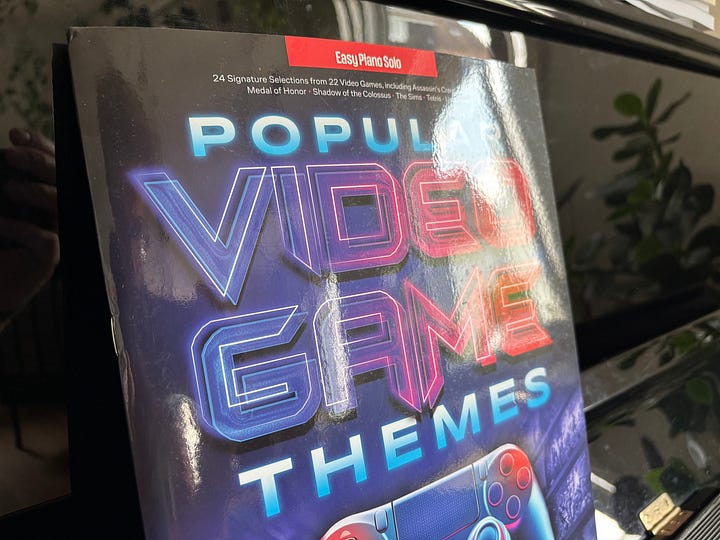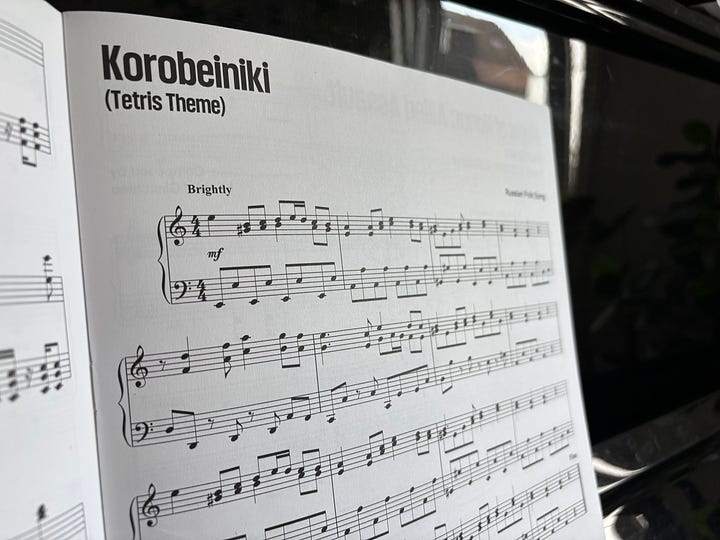When students ask "can I learn this song?"
The Magpie Method for Teaching Piano Arrangements
I bet you’ve experienced this: your student comes up to you and enthusiastically announces that they want to learn a song you’ve never heard of.
On the one hand you’re excited about their enthusiasm.
On the other hand, you’ve got to figure out how to fit it into their curriculum in a way that makes sense.
I’ve encountered this so many times — countless! — and I’ve developed a method for dealing with it that I want to share with you. I find it really useful, and my students love the fact that they can make requests.
I call it the Magpie Method, and I’m going to show you how to use it with the wonderful piece ‘Korobeiniki’, better known as the Theme from Tetris.
That brings back intense memories from my youth!!
Why do I call it the ‘Magpie Method’?
Magpies famously love to collect lots of shiny objects in their nests. They pick and choose the brightest, most interesting pieces to make something unique and special.
In the same way, the Magpie Method encourages your students—and you—to collect favourite musical ideas from different arrangements, combining them to create something new and personal. It’s a creative, flexible approach that engages their enthusiasm, while still supporting your students’ musical growth, because you can help them write an arrangement that they can actually play.
That’s the problem with using a pre-existing arrangement: it’s usually either too hard (so they get discouraged) or it’s too easy (so they get bored). The Magpie Method helps you find the happy middle ground.
How does it work?
You’ll need to find a lead sheet, plus a couple of pre-written arrangements of the piece.
You begin the Magpie Method by teaching the piece just the same as you would any other lead sheet: play the chords as block chords, add the melody.
Here’s the lead sheet for the piece from the newly published Video Game Music: Super Easy Songbook, published by Hal Leonard. This score includes diagrams of the block chords, which make it a great resource for a student who has never played a lead sheet before.


But it really starts to get interesting when you start looking at the other arrangements. Here are a couple of samples from more advanced books also from Hal Leonard:


In this first example, from Popular Video Game Themes: Easy Piano, there’s a thin texture, with the left hand sometimes harmonising the melody (e.g. in bar 1) or playing a simple bass line made up of notes 1 and 5 of the chord. From bar 5 onwards the right hand has occasional harmony notes.


In this second example from Popular Video Game Themes: Piano Solo, the right hand harmonises itself with either thirds or sixths, while the left hand often plays a simple octave pattern on the root of the chord.
Imagine the second example is too difficult for your student, the first too easy. By helping your student pick their favourite elements from both arrangements to find something somewhere of a manageable difficulty, you’ll be able to make a nice compromise.
So, using Koribeiniki as an example, you might try combining the right hand from the Easy Piano Solo version with the left hand from the Piano Solo edition.
Or you might take the idea of the harmonised melody thirds from the Piano Solo edition, and combine it with an easier bassline, maybe just playing the root of the chord as crotchets/quarter notes.
I could go on — there are so many potential combinations!
And I’m just scraping the surface, because there are so many fun versions of Koribeiniki on YouTube, so you can also send them off with homework to discover their own favourite!
Why teach arrangement using the Magpie Method?
First, this approach encourages exploration and curiosity. Instead of simply learning a single version of a piece, students get the chance to explore several arrangements. This exposes them to different musical choices and styles, broadening their horizons and helping them develop a more critical ear.
Second, the Magpie Method builds critical listening skills. Students must identify what they like about each arrangement—whether it’s the melody, harmony, rhythm, or texture. This process helps them articulate their musical preferences and understand why certain choices work better for them.
Third, it promotes ownership and confidence. When students collect their favorite ideas and combine them into a new arrangement, they become co-creators rather than just performers. This sense of ownership is incredibly motivating and helps them take pride in their music.
Finally, this method makes learning fun and interactive. The process feels like a treasure hunt, with students excited to discover and share the “shiny” musical ideas they find. It turns a simple request to learn a song into a creative adventure, keeping lessons fresh and inspiring.
In short, teaching arrangement this way isn’t just about learning a piece—it’s about developing creativity, critical thinking, and a lifelong love for music.
Tips for using the Magpie Method effectively
When guiding your students through the Magpie Method, remember: your role is to be a supportive guide, not a director. Encourage your students to take the lead in choosing and combining their favorite musical ideas.
At the same time, foster their curiosity by asking open-ended questions—like “What do you like most about this arrangement?” or “Why does that part stand out to you?” These simple strategies help empower your students and make the creative process even more rewarding.
A note on the books
If you have intermediate students who enjoy video game music, Popular Video Game Themes: Piano Solo and Popular Video Game Themes: Easy Piano work brilliantly for this approach because the song list for both books is the same, and it’s really comprehensive. See below for the full list of songs:




Here's a link to my favorite (mind blowing) and deeply authentic rendition, which is the way I discovered the piece, on a CD called "Russia's Most Beautiful Music." https://youtu.be/E__Q4mmPKLY?si=4-tUmztT8vqj738x
This is lovely. I’ve come back to the piano after forty years and am really enjoying it. I played guitar and mandolin in between, but piano was my first love — I got to Grade 7 back in the day, glued to the books. This time round, I’m playing by ear and just exploring. I’m enjoying your writing too. Funnily enough, I wrote about magpies a few days ago — though in a very different context.